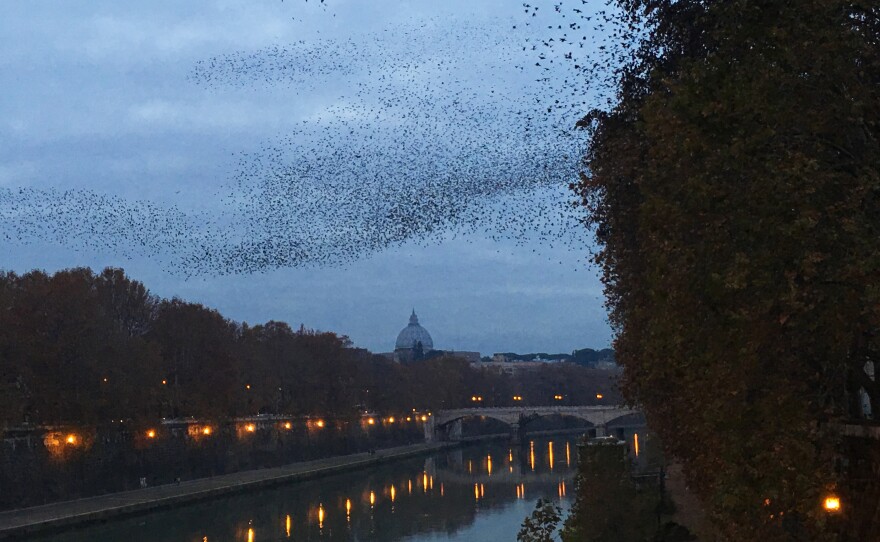
In winter, Rome has one of the mildest climates among European cities. It attracts not only off-season tourists, but also migratory birds such as starlings, which may be outliving their welcome.
For much of the day, Rome's visiting starling population feeds in olive groves in the countryside. Well-fed, they start making their presence in the city known in mid-afternoon.
That's when walking under tree-lined streets becomes dangerous.
Kids run fast to avoid being hit by bird droppings. It's not raining, but Marianna Totti crosses the Ponte Sisto over the Tiber River under an umbrella.
"This is what we have to deal with," she says. "If it doesn't rain and wash down the streets, bird droppings are everywhere. The stench is nauseating. I come this way every day, so it's a constant risk for me."
Cars parked along streets lined with tall trees are encrusted with sticky guano that's hard to remove. Many sidewalks and streets have become hazardous.
At the corner of Ponte Garibaldi and the avenue running along the Tiber, Gianfranco Mascia, spokesman for the Rome Greens movement, points to a white substance that's been spread over the gooey asphalt.
"Yesterday, several motorcycles skidded and fell over, so city workers poured that stuff over the guano," he says. "It's like spreading sand on ice to make it less slippery."
With many trees still thick with foliage providing shelter for the birds, one of the causes of the starling crisis this year is global warming, Mascia says.
"As long as it's warm," he says, "these birds will stay. Who can blame them?"
In past years, the city used special speakers that emit sounds of predators or starling distress calls that made the birds fly away, out of Rome.
But city services have been in a state of disarray since Rome's municipal government was forced to step down in October over a financial scandal, before all budget items could be approved.
In mid-November, the caretaker administration turned to a falconer for help.
Loris Maltalenti told an online publication that his falcons, which are used to chase seagulls and pigeons away from food depots, would get rid of the pesky flocks.
But in the battle of the birds, the tiny starlings prevailed. No one has since seen the falcons.
It's true, starlings are noisy and smelly, and their droppings are a hazard for traffic and pedestrians. But they're also star performers.
At dusk, flocks in the tens of thousands dance above the trees in an aerial display of perfectly synchronized choreography called a "murmuration."
For a few moments, even world-weary Romans stop in their tracks and gaze upward as swarms of starlings entertain them with a dazzling twilight ballet in the skies.
Copyright 2015 NPR. To see more, visit http://www.npr.org/.






